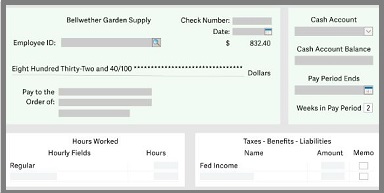How to Calculate Time and a Half in Sage 50 Payroll

Payroll is an essential pillar in any up and running firm. Just like any functioning sector, understanding of industry jargon is of utmost importance and worth holding. To calculate payroll at large corporations necessarily requires the use of myriad modus operandi.
User Navigation
- What Exactly does Time and a Half Pay Imply?
- When do Businesses Need to Provide Time and a Half?
- Who are Non-Exempt Workers or Hourly Workers
- Exempt Workers
- How can one Calculate Time and a Half Pay?
- Here’s How to Calculate FLSA Time and Half Payments:
- Calculating Time and Half for Hourly Employees
- Final Words
- Accounting Professionals & Specialized Experts
- Frequently Asked Questions(FAQs)
In simple words, when an employee works for any hours in excess of the forty-hour week i.e.; overtime work. Time and a Half pay particularly refers to overtime pay for the overtime working hours. Overtime pay is commonly estimated at the time and a half the regular hourly rate.

What Exactly does Time and a Half Pay Imply?
Time and a Half Pay directly means that, in addition to the employee’s regular hourly rate, they will be paid one-half of that rate for each hour worked(overtime hours) during the time and a half window.
According to the law, Time and a Half pay are decided by The federal Fair Labor Standards Act(FLSA) establishes the requirements and conditions for overtime pay. Although the overtime pay rate may vary from company to company. The regular pay plus is an additional fifty percent, which states that overtime pay is 1.5 times a worker’s hourly rate.
When do Businesses Need to Provide Time and a Half?
As mentioned above, Time and a Half pay is a necessary pay scale that has to be offered to the overtime working employees without fail. In accordance with the hours they work extra, they are entitled to get the overtime wages as per the FLSA pay rule scale.
Now, under the FLSA, you must pay all hourly or non-exempt employees time and a half for overtime hours. If any firm fails to work according to the stated pay scale, they may have to face the consequences of a hefty bill or extra legal fees.
Time and a Half pay are only offered to hourly or non-exempt workers, whereas Exempt workers can not share this privilege.
Read More-: Step for Setup and Run Payroll in Sage 50
For better comprehension, Take a look over the differentiation between these two Non-exempt and Exempt workers:
Who are Non-Exempt Workers or Hourly Workers
Non-exempt employees are the ones who are paid on a salary, hourly, or other basis. They are entitled to overtime pay for all excess workload hours out of the forty workweek system.
Their annual salary is a little less than $35,568. Non-exempt employees are usually paid on an hourly basis. They may, however, be reimbursed in some cases.
Non-exempt workers are included in FLSA, Their positions are non-exempt, which means they do not have high-level administrative, executive, computer, or professional responsibilities. On the other hand, let’s take a look at Exempt employees.
Exempt Workers
An Exempt is an employee who is excluded by FLSA and has no access to overtime pay. The process generally involves being salaried employees.
Their annual salary is mainly more than $35,568. They work in jobs that are usually not covered by the FLSA. High-level management positions include administrative, executive, and information technology positions.
Some contract workers might be separate and distinct from the FLSA. Lorry drivers, agricultural workers, and theatrical and film employees are examples of people who work in the food industry.
How can one Calculate Time and a Half Pay?
Time and a Half pay is also known as overtime pay and is estimated on a weekly or even daily basis, usually depending on the status of the working hours of an employee carried out in a single day.
Time and a Half = standard hourly rate x 1.5
For carrying out the process of calculating Time and Half Pay accurately, follow these steps:
- For the first step, proceed to Multiply the regular wage rate by 40 or the number of hours an employee has put in work.
- Ensure that you use the regular hourly rate multiplied by 1.5. This 1.5 is the amount per hour of overtime.
- Now for the next step, multiply this estimate by the number of extra hours worked. If an employee has worked for four hours extra time, then it will gradually multiply by four.
- For the last, proceed to add the outcomes from the numbers one and three in order to calculate the weekly rate, along with overtime pay accordingly.
This is a general procedure for calculating Time and Half pay. This procedure can however vary for calculating Time and Half pay for hourly workers and salaried workers.
To know more about this difference in the calculation process, take a look over the below-mentioned steps.
Here’s How to Calculate FLSA Time and Half Payments:
The Federal Fair Labour Standards Act (FLSA) necessitates that the overtime pay is at least one and a half times their regular hourly wage.
While carrying out the most important task i.e., doing payroll calculations, bear in mind that there lie’s individual processes for calculating time and a half pay for salaried and hourly employees accordingly.
Calculating Time and Half for Salaried Employees:
In order to calculate the total payment for fixed work hours per week salaried employee, take up the following steps:
- For the foremost step, proceed to divide the weekly wage by the number of hours they typically work to arrive at their standard rate of pay.
- After the subsequent step, now go to multiply the standard hourly rate by 1.5, to calculate the time and half pay.
- Now, in order to quantify the overtime pay, proceed to multiply the time and a half rate by the number of overtime hours worked by the employee.
- And then, Add together the employee’s standard wages and overtime wages to calculate the employee’s total wages for that pay period.
An example for your better understanding:
Grace has her weekly salary of $540 for working 36 hours. For instance, she worked the previous week for 42 hours, stating that she has completed two overtime hours above the 40-hour workweek.
Grace’s regular hourly pay rate: $540/36 hours= $15 per hour
According to the 40 per hour work week: 40 hours x $15= $600
Overtime pay rate of Grace: $15 x 1.5= $22.5
Now the overtime pay for the new week: 2 hours x $22.5= $45
The weekly gross pay is equal to the payment for a 40-hour workweek in addition to the overtime pay: $600 + $45= $645
Calculating Time and Half for Hourly Employees
To calculate Time and Half for Hourly Employees, take up the following steps:
- The first step for calculating the time and half pay for an hourly employee is to calculate the standard hourly rate of the employee.
- Now, for time and half pay rate, proceed to multiply the standard hourly rate by 1.5 respectively.
- For the next step, multiply the time and a half rate by the number of overtime hours worked by the employee in order to calculate the overtime pay.
- After the subsequent step, add the employee’s standard wages and overtime wages together, to determine the employee’s total wages for the following pay period.
Have a glance at the below example –
Now Luke is an employee from a company based in California, with generally more than 27 staff members. The minimum wage is $13.
The following week he completed a successful 46 hours work period. Working six hours over the standard 40-hour per week scale.
Luke’s overtime pay is: $13 x 1.5= $19.5
The standard payment for Luke: 40 hours x $13= $520
The payment for the overtime week is as follows: 6 hours x $19.5= $117
Now, Add his standard weekly payment to the overtime payment to get the total gross pay for the 46-hour workweek: $520 + $117= $637
Managing a company’s payroll is the most professional and critical sector. In short words, it portrays and regulates the fair compensation of its employees. To maintain this compensation fair and on time, there needs to be a deep understanding of Overtime pay processes.
Also Read: Sage Time and Attendance Management Software
Final Words
Acknowledging how to process the Time and a Half pay process effectively is a much complicated but necessary skill. In support of the following blog, it has fairly stretched out the needful information about Time and Half pay in a more direct approach for providing a more fruitful understanding.
If you need for Sage 50 technical support just Chat with Us or Dial our tollfree number.
Accounting Professionals & Specialized Experts
Want quick help from accounting software experts? Get in touch with our team members who can install, configure and configure your software for you. Proficient in fixing technical issues, they can help you quickly get back to work whenever you encounter an error in Sage software. Our team is available 24/7 365 days to assist you. To get in touch.
Frequently Asked Questions(FAQs)
Do all States focus and work according to the FLSA guidelines while considering Time and half-pay?
No, the FLSA is the US-based union board and there are many states who have adapted daily overtime standards to ensure the fair play of distribution of overtime wages for the employees who extend services outside the usual eight-hour workday. The most known state is California.
Is it possible to calculate Time and half for salaried workers with a fluctuating workweek?
Yes, it is fairly possible to do the same. Here’s how to do it:
However, their standard hourly rate will be different, according to the working hours.
🔹 The first is to calculate the hourly rate according to the week.
🔹 Now, to obtain the overtime pay, multiply the hourly wage rate by the number of hours worked extra and not by 1.5
🔹 Once you get the overtime pay, add the weekly salary with the overtime wage rate and finally get the gross pay.
How can one calculate Time and a Half for holidays?
For the calculation: Normal pay per day worked multiplied by 1.5 (for time-and-a-half) or 2 (for double-time) = Holiday Pay.
